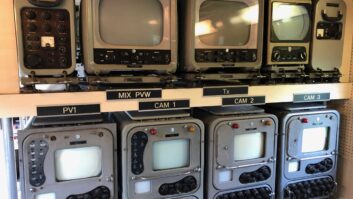
A projected 50% increase in satellite TV channels, growing demand for HD – and beyond – and the increasingly competitive news industry were the driving factors behind what was hot in the satellite industry at NAB, as Ian McMurray found out.
According to Ron Samuel, CEO of Eutelsat America, there were 31,000 satellite television channels broadcasting worldwide in 2011 and this is forecast to rise to over 47,000 channels by 2021. As such, it’s no surprise that his company, together with many others in the satellite industry, were at NAB to show off their latest and greatest offerings.
In Eutelsat’s case, that meant talking to visitors about how the company’s recently-launched satellites have strengthened their capacity to provide cost-effective solutions for contribution links from Asia and Australia into Europe, the Middle East and Africa. Another topic of conversation was Eutelsat’s launch in Europe in January of an Ultra HD demonstration channel as a platform to enable companies in the broadcast chain to test the performance of their equipment and the end to end chain.
“We believe satellites will be a natural platform for broadcasting Ultra HD content thanks to their bandwidth availability and coverage” said Samuel, noting that, of those 47,000 channels, almost a quarter are expected to be in high definition. “Ground still needs to be covered to improve compression and achieve industry-accepted standards. To bring quality Ultra HD content to the home, the new HEVC (High Efficiency Video Coding) compression standard should allow a significantly lower bit rate than current prevailing codecs such as H.264/MPEG-4 AVC. HEVC is generally considered by the industry to be one of the key elements towards wide deployment of 4K and 8K resolution.”
“Our commitment,” he continued, “is to providing capacity, reach and the highest quality of service to accommodate new channels, enable broadcasters to expand their channel offering and explore new formats. Beyond the pure broadcast opportunity, we are now also able to bundle TV with broadband services — using the KA-SAT High Throughput Satellite — for an all-satellite Triple Play experience.”
Inevitably, HD was a hot topic across the show floor. Among the three new – for the American market – products on show from Cobham were a new HD MPEG4 IP Encoder that, according to the company, enables a camera operator to instantly establish bi-directional communication and transmit live, broadcast-quality HD video from anywhere that has access to broadband connectivity. Also unveiled was the Solo Micro HD, a fully-featured COFDM digital video transmitter. The third new product was Cobham’s MediaMesh, which received its launch at IBC in September. MediaMesh is described as an IP-based platform that uses wireless technology designed for rapid set-up of a field newsroom to enable journalists to establish a live, two-way production system in minutes.
Stuart Brown, broadcast systems director at Cobham Broadcast, explained the thinking behind the new products. “In a “see it now” world, we believe it is vital that journalists and producers are not only able to get to a scene first, but be first to transmit live video and audio while events are unfolding,” he said. “In their respective applications, MediaMesh and the new HD encoder do just that.”
“As for the Solo Micro HD, it’s no longer enough to cover events, particularly sports, with traditional camera angles tethered to wired cameras,” he continued. “Solo Micro HD enables producers to capture and transmit stable, high definition images from positions previously unheard of, which adds considerable drama to the occasion and greatly enhances the viewing experience.”
So what does Brown think Cobham can offer that’s different? “Speed, reliability, rapid response and, oh – more speed!” he laughed. “We’re entering an age of technology that will deliver the ability to cover events of any kind, anywhere in the world, at a moment’s notice. Fortunately, that’s precisely what the industry and consumers around the world are demanding – and precisely what we are offering.”
The next revolution in SNG?
Cobham’s name cropped up in discussions on the Inmarsat stand as well. Inmarsat unveiled what the company described as “the next revolution in satellite newsgathering” in the shape of Cobham SATCOM’s Explorer 710. According to the company, it is the latest Broadband Global Area Network (BGAN) terminal and the first that will be capable of accessing Inmarsat’s new high data rate service (HDR), which will offer media organisations and broadcasters significantly increased streaming rates for higher quality video newsgathering. The Explorer 710 is a plug’n’play device and features a built-in bonding capability, which will result in connection speeds that previously needed a VSAT uplink.
“BGAN HDR is taking video newsgathering to a whole new level,” said Martin Turner (pictured), director of media industry at Inmarsat.
Scheduled for commercial launch later this year, its full channel option will provide broadcasters with an expected streaming rate of around 650kbps which, when combined with the EXPLORER 710 terminal, will deliver what Turner believes will be a step-change in video quality.
“Inmarsat has an outstanding record of continual innovation and HDR is a good example of this in action,” continued Turner. “There are enormous changes taking place in both the satellite and broadcast industries, and Inmarsat understands the need for broadcasters to move more data, more quickly – and to achieve higher video quality. HDR will address these requirements, while making BGAN even more portable and easy to use than it is now.”
“No other service offers comparable streaming speeds,” he concluded, noting that HDR also has an asymmetric service so that broadcasters only pay for the data connection they need – and there is a half channel service for less demanding live requirements.
World’s smallest and lightest
Also with its eyes fixed on that lonely news-gatherer was Vislink, who were showing the new Mantis MSAT which the company claims is the world’s smallest and lightest satellite data terminal for high-performance high-definition satellite news gathering. Deployed from a single lightweight backpack, the MSAT offers full support for two-way video, voice and data communications and can be carried and deployed by just one person for satellite newsgathering.
Weighing jut 14kgs and with a level of ruggedness – it is said to meet the MIL 810F & DEF-STAN military specifications for shock, vibration, sand and rain, enabling it to be deployed in extreme environmental conditions, it can, said Lance Hiley, the company’s chief marketing officer, be unpacked and working in less than five minutes.
“The new broadcast specification Mantis MSAT was expressly created to meet the growing demand from broadcasters around the world for a highly portable lightweight solution capable of delivering HD video, voice and data communications all in one unit,” noted Hiley. “Aside from being the lightest and smallest product of its kind currently available on the market, one of the main benefits of the new Mantis MSAT is that it operates on multiple bands – Ka, Ku and X bands. As a result, our customers can deploy the Mantis MSAT around the world and know it is going to be able to function quickly and effectively in any region.”
Burgeoning demand for HD – and, in the not-too-distant future, 4K and 8K resolution if industry projections are to be believed – together with the proliferation of satellite TV channels is putting a focus on the development of an infrastructure capable of the bandwidth required for moving huge numbers of pixels around the globe.
That trend was reflected on the Intelsat stand, where the company was showcasing its Intelsat EpicNG high-throughput satellite platform, which combines Intelsat’s spectral rights in C-, Ku- and Ka-band frequencies with wide beams, spot beams and frequency reuse technologies. Intelsat EpicNG will, it was said, provide greater efficiency and increased throughput compared with a traditional satellite.
The platform is described as backward compatible and, according to the company, complements Intelsat’s existing satellite fleet and the IntelsatOne network, meaning that customers can achieve higher throughput with their existing hardware. Intelsat said that the increased efficiency will result in a dramatic increase in the types of networks and applications that can be supported by satellite-based infrastructure.
“Intelsat EpicNG has changed the conversation when it comes to next-generation platforms,” said Jean-Philippe Gillet, regional vice president, Europe & Middle East, Intelsat, who points out that, combined, Intelsat EpicNG satellites will serve every populated region in the world, “because we addressed what service providers think about the most – total cost of ownership and reliability. Beyond that, Intelsat EpicNG will enable content regionalisation, such as by advertising, interstitials, time zone and language, and customisation by bitrate, resolution or encoding format.”
“Intelsat Epic will provide more throughput than traditional wide-beam capability, enabling providers to push HD content to smaller terminals,” he continued. “This will be part of Panasonic’s solution to deliver TV to aircraft and also will allow SNG customers to operate with smaller, lighter equipment. We work with our media customers to understand their challenges and distribution requirements into the future. Similar to our network services and government customers, we expect that our media customers will use a combination of our connectivities to optimise their networks.”






